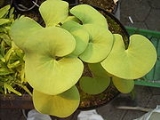
Utricularia reniformis
Encyclopedia
Utricularia reniformis is a large perennial
carnivorous plant
that belongs to the genus
Utricularia. U. reniformis is endemic to Brazil
. It was originally published and described by Augustin Saint-Hilaire
in 1830. It usually grows as a terrestrial plant in wet grasslands and only sometimes as an epiphyte
in the water-filled leaf axils of some bromeliad species. It is typically found between altitudes of 750 m (2,461 ft) and 1900 m (6,234 ft) in its southern range and up to 2500 m (8,202 ft) in its northern range. It has been collected in flower between October and March.
Perennial plant
A perennial plant or simply perennial is a plant that lives for more than two years. The term is often used to differentiate a plant from shorter lived annuals and biennials. The term is sometimes misused by commercial gardeners or horticulturalists to describe only herbaceous perennials...
carnivorous plant
Carnivorous plant
Carnivorous plants are plants that derive some or most of their nutrients from trapping and consuming animals or protozoans, typically insects and other arthropods. Carnivorous plants appear adapted to grow in places where the soil is thin or poor in nutrients, especially nitrogen, such as acidic...
that belongs to the genus
Genus
In biology, a genus is a low-level taxonomic rank used in the biological classification of living and fossil organisms, which is an example of definition by genus and differentia...
Utricularia. U. reniformis is endemic to Brazil
Brazil
Brazil , officially the Federative Republic of Brazil , is the largest country in South America. It is the world's fifth largest country, both by geographical area and by population with over 192 million people...
. It was originally published and described by Augustin Saint-Hilaire
Augustin Saint-Hilaire
Augustin François César Prouvençal de Saint-Hilaire , French botanist and traveler, was born at Orléans, France, on 4 October 1779. He began to publish memoirs on botanical subjects at an early age...
in 1830. It usually grows as a terrestrial plant in wet grasslands and only sometimes as an epiphyte
Epiphyte
An epiphyte is a plant that grows upon another plant non-parasitically or sometimes upon some other object , derives its moisture and nutrients from the air and rain and sometimes from debris accumulating around it, and is found in the temperate zone and in the...
in the water-filled leaf axils of some bromeliad species. It is typically found between altitudes of 750 m (2,461 ft) and 1900 m (6,234 ft) in its southern range and up to 2500 m (8,202 ft) in its northern range. It has been collected in flower between October and March.

